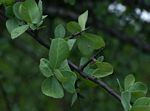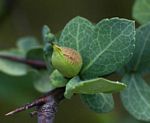Commiphora viminea
Selected images: Click on each image to see a larger version and details of the record View all images (4)
Records: Display species records Map species using Google Maps
Species details: Click on each item to see an explanation of that item (Note: opens a new window)
| Synonyms: |
Commiphora merkeri Engl. |
| Common names: | Chifata (Hlengwe) Mupopo (Tonga: Zimbabwe) Siachimvwa (Tonga: Zimbabwe) Zebra-bark commiphora (English) |
| Description: | Single-stemmed small tree. Bark creamy-grey or pale greenish with blackish horizontal bands of rough lenticels; young branches purplish, spine-tipped. Leaves clustered on small lateral spine-tipped branchlets, usually simple (1-foliolate), obovate, up to 4.5 × 2.5 cm, bluish-green, hairless except for long glandular hairs near the base; margin scalloped; petiole very short to absent. Flowers in small inconspicuous clusters on the spur-branchlets, yellowish, appearing just before or with the new leaves. Fruit ellipsoid, up to 1.3 cm long, pointed, hairless, reddish-brown when ripe, splitting to reveal a black seed with a 4-lobed yellow pseudo-aril, almost completely covering the seed. |
| Notes: | |
| Derivation of specific name: | viminea: with long, flexible shoots |
| Flowering time: | Dec - Jan |
| Worldwide distribution: | Botswana, Mozambique, northern Namibia, Kenya, Tanzania, Zimbabwe and Limpopo, Mpumalanga, South Africa |
| Growth form(s): | |
| Insects associated with this species: | |
| Spot characters: | Display spot characters for this species |
| Image last updated: | Friday 4 April 2008 |
| Literature: |
Burrows, J.E., Burrows, S.M., Lötter, M.C. & Schmidt, E. (2018). Trees and Shrubs Mozambique Publishing Print Matters (Pty), Cape Town. Page 378. (Includes a picture). Drummond, R.B. (1975). A list of trees, shrubs and woody climbers indigenous or naturalised in Rhodesia. Kirkia 10(1) Page 249. As Commiphora merkeri Heath, A. & Heath, R. (2009). Field Guide to the Plants of Northern Botswana including the Okavango Delta Kew Publishing Page 225. as Commiphora merkeri (Includes a picture). Mapaura, A. & Timberlake, J. (eds) (2004). A checklist of Zimbabwean vascular plants Southern African Botanical Diversity Network Report No. 33 Sabonet, Pretoria and Harare Page 31. Setshogo, M.P. (2005). Preliminary checklist of the plants of Botswana. Sabonet Report no. 37. Sabonet, Pretoria and Gaborone Page 42. as Commiphora merkeri Wild, H. (1963). Burseraceae Flora Zambesiaca 2(1) Page 269. As Commiphora merkeri (Includes a picture). |
Other sources of information about Commiphora viminea:
Our websites:
Flora of Botswana: Commiphora vimineaFlora of Mozambique: Commiphora viminea
Flora of Zambia: Commiphora viminea
Flora of Zimbabwe: Commiphora viminea
External websites:
African Plants: A Photo Guide (Senckenberg): Commiphora vimineaAfrican Plant Database: Commiphora viminea
BHL (Biodiversity Heritage Library): Commiphora viminea
EOL (Encyclopedia of Life): Commiphora viminea
GBIF (Global Biodiversity Information Facility): Commiphora viminea
Google: Web - Images - Scholar
iNaturalist: Commiphora viminea
IPNI (International Plant Names Index): Commiphora viminea
JSTOR Plant Science: Commiphora viminea
Mansfeld World Database of Agricultural and Horticultural Crops: Commiphora viminea
Plants of the World Online: Commiphora viminea
Tropicos: Commiphora viminea
Wikipedia: Commiphora viminea



